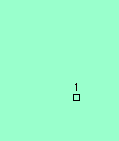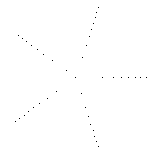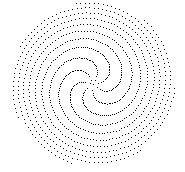Image: Jan Plogmann/Flickr
Start with rabbits.There are two of them, a boy and a girl. They get up to some rabbit business, and soon enough there are two more rabbits, another boy and another girl. Two adult rabbits, and two baby rabbits. The baby rabbits mature, leaving four adult rabbits. Next, the first pair, the two original rabbits, have two more rabbits, another boy and another girl. Four adult rabbits, two baby rabbits. The two baby rabbits mature, leaving six adult rabbits. The second and third pairs of rabbits each have a new pair of baby rabbits. Six adult rabbits, four baby rabbits. Soon, there are lots and lots of rabbits.This was the original problem being considered by the great Middle Ages mathematician Leonardo Fibonacci. Given two adult rabbits, how many rabbits can we imagine being produced in a year's time, assuming the unlikelihood that each rabbit pair produces an identical rabbit pair (another boy and another girl rabbit).The revelation seems trivial: the number of total rabbits in a given iteration is the number of baby rabbits and adult rabbits of the previous iteration combined. So: 2-0, 2-2,4-2,6-4,10-6,14-6 …In other words, the number of adult rabbits in a given iteration is the number of adult rabbits in the previous iteration plus the number of adult rabbits in the iteration before that. Here it is mathematically, the recursive form of the Fibonacci sequence: The above is probably the most famous recursive relationship in mathematics (and computer science). It's taught relentlessly, and for good reason.So, for our rabbits, if we look at each pair as a single unit, we get these famous numbers:1, 1, 2, 3, 5, 8, 13, 21, 34, …It's almost too simple, but as with many simple but elegant mathematical ideas, it winds up being a very powerful description of real-world things, often within nature. In particular, it offers an idealized form to match many sorts of growth we observe out in the world, which seems reasonable enough: a thing is likely the product (or summation, actually) of its previous forms. I am the result of my past, as are you of your past.If not for IRL rabbits, the sequence happens to work very well for bees. Reproduction is a bit wacky in a bee colony, where there is just a single mother queen bee and males are produced from unfertilized eggs. Meaning, male bees have only a mother and no father. Female bees, meanwhile, are the result of mating between the queen and a dude bee.Rod Knott, a computer scientist at the University of Surrey, offers a whole web labyrinth dedicated to the sequence and lays out the male drone's odd family tree as such:He had 1 parent, a female.He has 2 grand-parents, since his mother had two parents, a male and a female.He has 3 great-grand-parents: his grand-mother had two parents but his grand-father had only one.Now we can ask, how many great-grandparents does he have? We already know the answer. 1, 1, 2, 3, 5, 8, 13, 21, 34, … Our two-parent family tree, meanwhile, is just two multiplied some number of times, giving the more expansive 2, 4, 8, 16, 32, 64, 128 …There is another related feature of the Fibonacci sequence that gives it an odd (not not actually unexpected) twist. Take a number from the sequence and divide it by the previous number, and keep doing that as you progress down the line. So, we have 1/1, 2/1, 3/2, 5/3, 8/5 … and if we graph those values, what we get is nothing less than the Golden Ratio, as the value of the Fibonacci fractions settles at around 1.68 033988749894848204586834 …, but never really settles, adding digits forever.The connection is clear in the forever-spirals of Fibonacci rectangles and their natural world counterparts, such as seashell swirls and pine cone segments.
The above is probably the most famous recursive relationship in mathematics (and computer science). It's taught relentlessly, and for good reason.So, for our rabbits, if we look at each pair as a single unit, we get these famous numbers:1, 1, 2, 3, 5, 8, 13, 21, 34, …It's almost too simple, but as with many simple but elegant mathematical ideas, it winds up being a very powerful description of real-world things, often within nature. In particular, it offers an idealized form to match many sorts of growth we observe out in the world, which seems reasonable enough: a thing is likely the product (or summation, actually) of its previous forms. I am the result of my past, as are you of your past.If not for IRL rabbits, the sequence happens to work very well for bees. Reproduction is a bit wacky in a bee colony, where there is just a single mother queen bee and males are produced from unfertilized eggs. Meaning, male bees have only a mother and no father. Female bees, meanwhile, are the result of mating between the queen and a dude bee.Rod Knott, a computer scientist at the University of Surrey, offers a whole web labyrinth dedicated to the sequence and lays out the male drone's odd family tree as such:He had 1 parent, a female.He has 2 grand-parents, since his mother had two parents, a male and a female.He has 3 great-grand-parents: his grand-mother had two parents but his grand-father had only one.Now we can ask, how many great-grandparents does he have? We already know the answer. 1, 1, 2, 3, 5, 8, 13, 21, 34, … Our two-parent family tree, meanwhile, is just two multiplied some number of times, giving the more expansive 2, 4, 8, 16, 32, 64, 128 …There is another related feature of the Fibonacci sequence that gives it an odd (not not actually unexpected) twist. Take a number from the sequence and divide it by the previous number, and keep doing that as you progress down the line. So, we have 1/1, 2/1, 3/2, 5/3, 8/5 … and if we graph those values, what we get is nothing less than the Golden Ratio, as the value of the Fibonacci fractions settles at around 1.68 033988749894848204586834 …, but never really settles, adding digits forever.The connection is clear in the forever-spirals of Fibonacci rectangles and their natural world counterparts, such as seashell swirls and pine cone segments.
 You can also see it in plants, Take the "sneezewort," one example of a plant that produces new growth shoots according to the Fibonacci pattern.
You can also see it in plants, Take the "sneezewort," one example of a plant that produces new growth shoots according to the Fibonacci pattern. This goes on and on, from the packing of seed pods in sunflowers to the number of petals on a wide variety of different flowers to the number of leaves found on a given plant "per turn." It really is hanging out everywhere, but this shouldn't be surprising.There's nothing mystical about the Fibonacci sequence and nature at all. It's just a matter of efficiency. It's the best way to fit as many different objects into a given space as possible. As Knott explains, the most optimal way to pack round objects together is using the hexagonal arrangement below, but that only works if the objects never change in size. If you were to make those circles bigger and bigger, you'd see a lot of empty, wasted space.
This goes on and on, from the packing of seed pods in sunflowers to the number of petals on a wide variety of different flowers to the number of leaves found on a given plant "per turn." It really is hanging out everywhere, but this shouldn't be surprising.There's nothing mystical about the Fibonacci sequence and nature at all. It's just a matter of efficiency. It's the best way to fit as many different objects into a given space as possible. As Knott explains, the most optimal way to pack round objects together is using the hexagonal arrangement below, but that only works if the objects never change in size. If you were to make those circles bigger and bigger, you'd see a lot of empty, wasted space. Plants grow. That's what they do. And it turns out that for growing objects, the Fibonacci sequence is the most efficient packing scheme. The reason has to do with the irrationality of the Golden Ratio (and so the irrationality of the sequence).And to be irrational, what we mean is that the number cannot be expressed as the ratio of two integers (or whole, counting numbers), like ½ or ⅓ and so on. We can keep slicing the thing forever, but we'll never find a slice size small enough such that we can say that we have this many slices of one size on this side and, using the same sized slice, say that we have another number of slices on the other side. This ratio doesn't exist.This is good if you're a plant trying to maximize sunlight exposure. Every time you, the plant, grow a new leaf, it will be located some fraction of a turn from the leaf below. Imagine an existing leaf is at 12 o'clock. Where would you, the plant, want to grow your next leaf? If you chose, say, to put it one-half turn (at 6 o'clock) from the existing leaf, and kept doing that, you'd wind up with a spiral staircase of leaves, which would ultimately waste tons of space. The same thing would happen with any rational number of turns.For ⅗, you get the seed pod distribution below on the left, which is not very efficient at all. Pi next to it does better as it's actually irrational, but it's an irrational number well approximated by the fraction 22/7, which is rational.
Plants grow. That's what they do. And it turns out that for growing objects, the Fibonacci sequence is the most efficient packing scheme. The reason has to do with the irrationality of the Golden Ratio (and so the irrationality of the sequence).And to be irrational, what we mean is that the number cannot be expressed as the ratio of two integers (or whole, counting numbers), like ½ or ⅓ and so on. We can keep slicing the thing forever, but we'll never find a slice size small enough such that we can say that we have this many slices of one size on this side and, using the same sized slice, say that we have another number of slices on the other side. This ratio doesn't exist.This is good if you're a plant trying to maximize sunlight exposure. Every time you, the plant, grow a new leaf, it will be located some fraction of a turn from the leaf below. Imagine an existing leaf is at 12 o'clock. Where would you, the plant, want to grow your next leaf? If you chose, say, to put it one-half turn (at 6 o'clock) from the existing leaf, and kept doing that, you'd wind up with a spiral staircase of leaves, which would ultimately waste tons of space. The same thing would happen with any rational number of turns.For ⅗, you get the seed pod distribution below on the left, which is not very efficient at all. Pi next to it does better as it's actually irrational, but it's an irrational number well approximated by the fraction 22/7, which is rational.
 So, nature has settled on the Golden Ratio and the Fibonacci sequence representing it for its space maximization problem. Things that work in nature persist and not only is the Golden Ratio an irrational number, it happens to be the most irrational number, with the weakest possible approximations. A technology of the natural world, if you will.
So, nature has settled on the Golden Ratio and the Fibonacci sequence representing it for its space maximization problem. Things that work in nature persist and not only is the Golden Ratio an irrational number, it happens to be the most irrational number, with the weakest possible approximations. A technology of the natural world, if you will.
Advertisement
Advertisement
Advertisement

Advertisement
